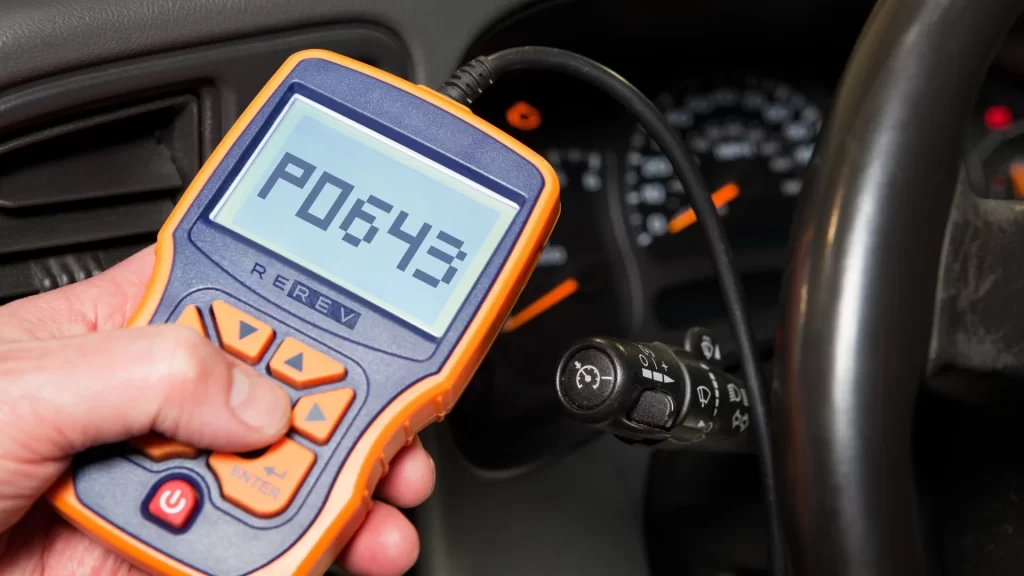
P0643 Reference voltage sensor circuit “A” high
Content
P0643 – OBD-II Trouble Code Technical Description
Trouble code P0643 indicates that the voltage on the sensor reference voltage circuit “A” is too high (compared to the value specified in the manufacturer's specifications).
What does the fault code mean P0643?
Trouble code P0643 indicates that the sensor reference voltage circuit “A” is too high compared to manufacturer specifications. This means that the powertrain control module (PCM), engine control module (ECM), or other vehicle accessory control module has detected unusually high voltage on this circuit. The Engine Control Module (ECM) typically has three 5-volt reference circuits that feed various sensors. Each circuit is designed to supply a reference voltage to specific sensors. Typically, circuit “A” is responsible for supplying a reference voltage to the accelerator pedal position sensor.

Possible reasons
Some possible reasons for the P0643 code:
- Damaged wire or connector in the reference voltage circuit: Damage to wires or connectors can cause a short or open circuit, which can cause high voltage.
- Sensor malfunction: If the sensor receiving the reference voltage from circuit “A” is damaged or malfunctioning, it can cause abnormally high voltage in the circuit.
- Engine control module (ECM) or powertrain control module (PCM) malfunction: The vehicle control module itself may be damaged or malfunctioning, causing it to produce incorrect voltage signals.
- Problems with the grounding system: Improper grounding can also cause errors in the voltage reference circuit, which can cause code P0643 to appear.
- Generator fault: If your vehicle's alternator fails or produces too much voltage, it can also cause P0643.
What are the symptoms of a fault code? P0643?
Some possible symptoms when trouble code P0643 is present:
- Check Engine Indicator: If P0643 is present, the Check Engine Light or MIL (Malfunction Indicator Lamp) may illuminate on your dashboard to indicate a problem.
- Power Loss: There may be a decrease or loss of engine power due to incorrect operation of the control system.
- Unstable idle: The vehicle may have a rough or shaky idle due to malfunctioning sensors or the control system.
- Poor fuel economy: Increased fuel consumption or decreased efficiency may be due to improper operation of the control system.
- Unstable speed: Problems with engine speed may occur, such as rattling or changes in speed for no apparent reason.
How to diagnose a fault code P0643?
The following steps are recommended to diagnose and resolve DTC P0643:
- Checking connections and wiring: Check all electrical connections associated with the sensor reference voltage “A” circuit, including connectors, pins, and wires for damage, corrosion, or breaks.
- Voltage check: Using a multimeter, measure the voltage in circuit “A” of the sensor reference voltage. Make sure the voltage meets the manufacturer's specifications.
- Checking the sensors: Check the condition and functionality of the sensors that receive reference voltage from circuit “A”. Make sure the sensors are not damaged and are connected correctly.
- Checking the Engine Control Module (ECM): Check the engine control module for defects or malfunctions. Specialized ECM diagnostic equipment may be required.
- Reset errors: After thoroughly checking and fixing the problem, reset the trouble code and take it for a test drive to make sure the problem is resolved.
If the problem cannot be identified or resolved on your own, it is recommended that you contact a qualified automotive technician or auto repair shop for further diagnosis and repair.
Diagnostic errors
When diagnosing DTC P0643, the following errors may occur:
- Incorrect interpretation of data: One of the main mistakes can be incorrect interpretation of the data obtained when checking the voltage or condition of the wiring. This may lead to an erroneous determination of the cause of the malfunction.
- Incorrect component replacement: If a thorough diagnosis is not carried out, there is a risk of replacing components unnecessarily. This can result in additional time and resources being spent without solving the underlying problem.
- Ignoring other potential problems: By focusing on one specific problem, you may miss other potential causes of failure. It is important to consider all possible factors that affect the sensor voltage reference circuit.
- Incorrect sensor connection: When checking the sensors, you should ensure that they are connected correctly and meet the manufacturer's specifications. Incorrect connection may lead to incorrect diagnostic results.
- Hardware problems: Insufficiently accurate or faulty diagnostic tools can lead to incorrect conclusions. It is important to use reliable and calibrated equipment for accurate diagnosis.
To avoid these mistakes, it is recommended to carry out diagnostics carefully, following the manufacturer's procedures and recommendations, and, if necessary, seek help from experienced professionals.
How serious is the fault code? P0643?
Trouble code P0643 indicates that the sensor reference voltage circuit is too high. This can be a serious problem that affects the operation of various vehicle systems such as the fuel injection system, ignition system and others. If left unaddressed, this problem can lead to poor engine performance, loss of power, poor fuel economy, and increased exhaust emissions.
In addition, insufficient voltage in the reference voltage circuit can cause problems with the engine management system and other vehicle systems, which can affect driving safety and reliability.
So, although this trouble code may not be immediately critical, it is important to take it seriously and have it diagnosed and repaired as soon as possible to avoid more serious consequences.
What repair will help eliminate the code? P0643?
To resolve DTC P0643, follow these steps:
- Testing the Reference Voltage Circuit: First, check the reference voltage circuit for shorts or opens. This can be done using a multimeter by measuring the voltage at the corresponding connector pins.
- Checking the Accelerator Pedal Sensors and Sensors: Check the sensors that are powered by the reference voltage circuit, such as the accelerator pedal position sensor. Make sure they are working properly and have the correct voltage.
- Inspect Wiring and Connectors: Check wiring and connectors for damage, corrosion, or poor contacts. Repair or replace damaged parts.
- Replacing the PCM/ECM: If all of the above steps do not resolve the problem, the PCM/ECM itself may be faulty. In this case, replacement or reprogramming of the engine control module is necessary.
- Additional repair measures: Sometimes the problem can be caused by other factors, such as a short circuit in another vehicle system. In this case, additional diagnostics and repairs are required.
After completing these steps, you should test the car to see if an error has occurred. If done correctly, the P0643 code should resolve. If the problem persists, it is recommended that you contact a car diagnostics and repair specialist for a more in-depth analysis.
P0643 – Brand-specific information
Trouble code P0643 can be found on various brands of cars, a list of some brands with their meanings:
- Ford: Sensor A reference voltage is high.
- Chevrolet: Sensor A reference voltage is high.
- Volkswagen: Sensor A reference voltage – circuit high.
- Toyota: Sensor A reference voltage – circuit high.
- Honda: Sensor A reference voltage is high.
- BMW: Sensor A reference voltage – circuit high.
- Mercedes-Benz: Sensor A reference voltage is high.
- Audi: Sensor A reference voltage – circuit high.
These are just some of the possible interpretations of the P0643 code for various makes of vehicles. It is important to note that the exact meaning of the code may vary depending on the model and year of manufacture of the vehicle. To accurately determine the cause of the malfunction, it is recommended to consult the service manual or consult a professional auto mechanic.


One comment
Diego Silva Resende
My car presents this fault intermittently, I clear the fault, use the car for a long time and then it appears as stored again.
How could I proceed with the diagnosis?